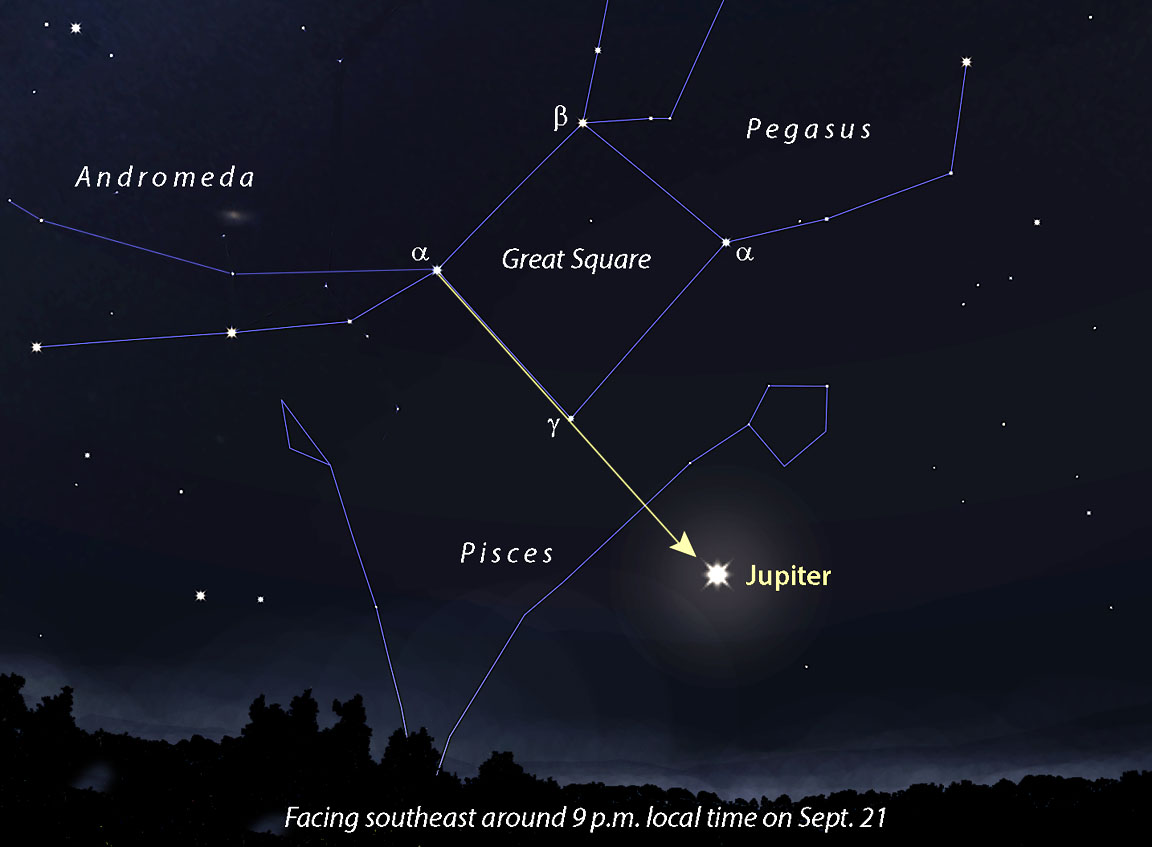[ Skywatchers ] [ Main Menu ]
46861
From: Eve, [DNS_Address]
Subject: ~ Jupiter at Opposition September 26th ~ constellation Pisces ~
|
-Earth and Jupiter in constellation Pisces -Sun in constellation Virgo (Mercury and Venus also in Virgo) EXCERPT: Jupiter at opposition This event is visible to the naked eye from Tampa. MON, 26 SEP 2022 AT 15:25 EDT (19:25 UTC) Dominic Ford, Editor From the Outer Planets feed Jupiter will reach opposition, when it lies opposite to the Sun in the sky. Lying in the constellation Pisces, it will be visible for much of the night, reaching its highest point in the sky around midnight local time. |
46863
From: Eve, [DNS_Address]
Subject: Re: Jupiter at Opposition on 9/26=Closest Approach to Earth in 59 yrs.
URL: Jupiter to Reach Opposition, Closest Approach to Earth in 59 Years!
|
Jupiter to Reach Opposition, Closest Approach to Earth in 59 Years! Beth Ridgeway Posted onSeptember 16, 2022 Categories NASA Stargazers can expect excellent views of Jupiter the entire night of Monday, Sept. 26 when the giant planet reaches opposition. From the viewpoint of Earth’s surface, opposition happens when an astronomical object rises in the east as the Sun sets in the west, placing the object and the Sun on opposite sides of Earth. Jupiter’s opposition occurs every 13 months, making the planet appear larger and brighter than any other time of the year. But that’s not all. Jupiter will also make its closest approach to Earth since 1963 – almost six decades ago! This happens because Earth and Jupiter do not orbit the Sun in perfect circles – meaning the planets will pass each other at different distances throughout the year. Jupiter’s closest approach to Earth rarely coincides with opposition, which means this year’s views will be extraordinary. At its closest approach, Jupiter will be approximately 367 million miles in distance from Earth, about the same distance it was in 1963. The massive planet is approximately 600 million miles away from Earth at its farthest point. “With good binoculars, the banding (at least the central band) and three or four of the Galilean satellites (moons) should be visible,” said Adam Kobelski, a research astrophysicist at NASA’s Marshall Space Flight Center in Huntsville, Alabama. “It’s important to remember that Galileo observed these moons with 17th century optics. One of the key needs will be a stable mount for whatever system you use.” Kobelski recommends a larger telescope to see Jupiter’s Great Red Spot and bands in more detail; a 4 inch-or-larger telescope and some filters in the green to blue range would enhance the visibility of these features. According to Kobelski, an ideal viewing location will be at a high elevation in a dark and dry area. “The views should be great for a few days before and after Sept. 26,” Kobelski said. “So, take advantage of good weather on either side of this date to take in the sight. Outside of the Moon, it should be one of the (if not the) brightest objects in the night sky.” Jupiter has 53 named moons, but scientists believe that 79 moons have been detected in total. The four largest moons, Io, Europa, Ganymede, and Callisto, are called the Galilean satellites. They are named after the man who first observed them in 1610, Galileo Galilei. In binoculars or a telescope, the Galilean satellites should appear as bright dots on either side of Jupiter during opposition. NASA’s Juno spacecraft, which has been orbiting Jupiter for six years, is dedicated to exploring the planet and its moons. Juno began its journey in 2011 and reached Jupiter five years later. Since 2016, the spacecraft has provided incredible images and data about Jupiter’s lively atmosphere, interior structures, internal magnetic field, and magnetosphere. Scientists believe studying Jupiter can lead to breakthrough discoveries about the formation of the solar system. Juno’s mission was recently extended until 2025 or until the end of the spacecraft’s life. Learn more about Juno. The next major project for Jupiter exploration is the Europa Clipper. This spacecraft will explore Jupiter’s iconic moon, Europa, which is known for its icy shell and vast ocean that lies beneath its surface. NASA scientists aim to find whether Europa has conditions able to sustain life. Europa Clipper’s targeted launch is currently scheduled for no earlier than October 2024. Learn more about the giant planet. And if you want to know what else is happening in the sky for September, check out Jet Propulsion Laboratory’s latest “What’s Up” video: ...more at link... |
Responses:
[46867]
46867

From: Eve, [DNS_Address]
Subject: Re: Jupiter at Opposition 9/26 = CLOSE ENCOUNTER
|
A CLOSE ENCOUNTER WITH JUPITER: Jupiter is about to have its closest encounter with Earth in 59 years. On Monday, Sept. 26th, the giant planet will be just 591 million kilometers away. Yes, that really is close. Look for Jupiter rising in the east at sunset shining four times brighter than Sirius, the brightest star in the sky. Through a backyard telescope it looks like this: 
|
Responses:
None
[ Skywatchers ] [ Main Menu ]